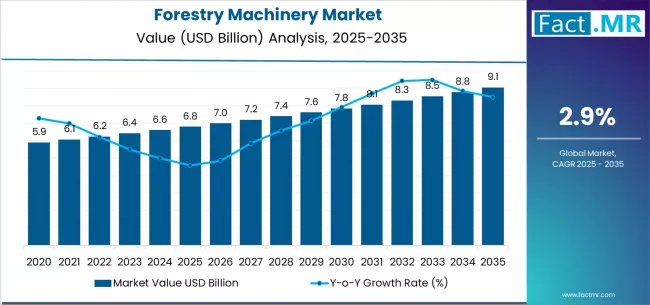The forestry machinery market is evolving rapidly as the global forestry sector embraces mechanization, sustainability, and efficiency in timber production and forest management. Modern forestry operations increasingly rely on advanced machinery to streamline activities such as harvesting, processing, planting, and maintenance.
Forestry machinery, including harvesters, forwarders, skidders, feller bunchers, and sawmills, plays a pivotal role in enhancing productivity while reducing labor-intensive processes. The growing emphasis on sustainable forest management, environmental compliance, and safety has significantly boosted demand for reliable, high-performance equipment across the globe.
Market Overview
Forestry machinery encompasses a broad range of equipment used throughout the lifecycle of forest operations. These machines are engineered to optimize timber extraction, reduce operational costs, and minimize environmental impact. Technological advancements have transformed traditional mechanical systems into intelligent, automated solutions capable of improving efficiency, precision, and safety.
Manufacturers are increasingly focusing on durability, fuel efficiency, and automation. Integration of GPS, telematics, and IoT-enabled monitoring systems is allowing forestry operators to track performance, predict maintenance needs, and ensure optimal utilization of resources. In addition, enhanced ergonomic designs are improving operator comfort and safety, further driving adoption in large-scale forest management operations.
Environmental sustainability is becoming a key driver of market growth. Eco-friendly machinery with lower emissions and reduced soil impact is preferred, particularly in regions with strict forestry regulations. The ability to process timber responsibly while conserving biodiversity is shaping purchasing decisions and operational strategies across the forestry industry.
Regional Insights
North America
North America is a major hub for forestry machinery adoption due to its extensive forest resources and well-established timber industry. The region emphasizes sustainable harvesting practices, automation, and integration of digital technologies in forestry operations. Investments in advanced equipment and mechanized forest management practices continue to drive demand.
Europe
Europe’s forestry sector prioritizes environmental stewardship and sustainable timber production. Stringent regulations and incentives for responsible forest management encourage the use of high-efficiency machinery. European manufacturers are leading innovations in low-emission engines, lightweight materials, and precision harvesting solutions to meet sustainability goals.
Asia-Pacific
Asia-Pacific represents a high-growth region for forestry machinery due to rapid infrastructure development, expanding timber industries, and increasing mechanization in countries like China, Japan, and India. Investments in plantation forestry, wood processing, and biomass production are driving demand for modern equipment.
Rest of the World
Latin America, Africa, and the Middle East are gradually increasing machinery adoption to improve productivity and promote sustainable forestry practices. The availability of forest resources and growing awareness of mechanization benefits are encouraging operators to replace traditional methods with modern machinery.
Key Trends & Forecast
- Automation and Smart Forestry Systems
Automated and semi-automated forestry machinery is gaining traction. GPS-guided harvesters, telematics-enabled forwarders, and sensor-equipped processing machines allow operators to monitor operations remotely, reduce errors, and optimize resource utilization. - Focus on Fuel Efficiency and Low Emissions
Manufacturers are developing fuel-efficient engines and hybrid systems that comply with global emission regulations. Reduced fuel consumption and environmental impact make machinery more sustainable and cost-effective for long-term forestry operations. - Adoption of Precision and Data-Driven Tools
Telematics, IoT, and digital mapping are being integrated into forestry machinery to monitor productivity, predict maintenance schedules, and ensure safe operations. Precision forestry enables better planning and minimizes environmental disruption. - Shift Toward Lightweight and Ergonomic Designs
Compact, mobile, and ergonomically designed equipment is in demand for operations in challenging terrains. Improved operator comfort and safety features reduce fatigue and improve efficiency. - Increased Emphasis on Sustainability
Machinery designed to minimize soil disturbance, prevent forest degradation, and optimize timber yield is gaining preference. Sustainable forestry practices are becoming central to government policies and corporate strategies, driving the adoption of eco-friendly equipment.
Applications & End-Use Outlook
Forestry machinery is widely used across multiple segments within the forestry ecosystem, contributing to efficiency, safety, and sustainability.
- Timber Harvesting: Harvesters, feller bunchers, and skidders streamline the cutting, collection, and transportation of logs from forests to processing facilities.
- Wood Processing: Sawmills, debarkers, and chippers improve timber processing efficiency and product quality, ensuring minimal waste.
- Plantation Management: Machinery used for planting, spacing, and soil preparation enhances plantation productivity while reducing manual labor.
- Forest Maintenance: Equipment for thinning, pruning, and fire management supports sustainable forest management and biodiversity conservation.
- Biomass and Energy Production: Forestry machinery facilitates the collection of residues for bioenergy, promoting renewable energy generation and waste valorization.
Integration with smart management platforms allows forestry operators to track performance metrics, optimize resource allocation, and maintain compliance with environmental regulations.
Challenges and Opportunities
The forestry machinery market faces challenges such as high capital investment, maintenance costs, and technical skill requirements for operating advanced equipment. Harsh terrain and variable weather conditions also impose operational constraints.
However, these challenges create opportunities for innovation. Manufacturers are introducing modular, durable, and user-friendly equipment that reduces operational complexity and downtime. Additionally, the rise of mechanized biomass harvesting, digital forestry management, and smart logging solutions offers new avenues for market growth.
Emerging technologies such as electric-powered machinery, autonomous harvesters, and AI-assisted planning tools provide opportunities to improve productivity while aligning with sustainability objectives. Strategic collaborations between manufacturers, forest management authorities, and research institutions are accelerating technological advancements in the sector.
Conclusion
The forestry machinery market is undergoing a transformative phase, driven by technological innovation, environmental sustainability, and the need for efficient timber production. Modern machinery is not only enhancing productivity and safety but also promoting sustainable forest management practices.
As industries adopt mechanized, data-driven, and eco-friendly solutions, forestry operations are becoming safer, more precise, and environmentally responsible. Investing in advanced forestry machinery ensures long-term operational efficiency, improved timber yield, and alignment with global sustainability goals, positioning the market as a critical enabler of the modern forestry ecosystem.
Browse Full Report – https://www.factmr.com/report/3732/forestry-machinery-market



